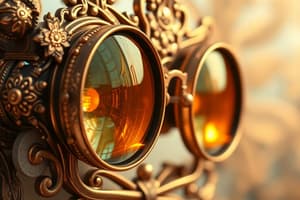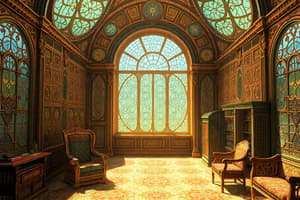Podcast
Questions and Answers
What is diffraction?
What is diffraction?
- The bending of light waves around an obstacle (correct)
- The restriction of light oscillations to a plane
- The combination of light waves resulting in cancellation
- The reflection of light from a surface
Virtual images can be projected onto a screen.
Virtual images can be projected onto a screen.
False (B)
What determines the characteristics of an image formed by lenses or mirrors?
What determines the characteristics of an image formed by lenses or mirrors?
The object's position relative to the lens or mirror.
The magnification of an image is the ratio of the image height to the ______ height.
The magnification of an image is the ratio of the image height to the ______ height.
Match the optical devices with their primary uses:
Match the optical devices with their primary uses:
Which type of lens is thicker at the center than at the edges?
Which type of lens is thicker at the center than at the edges?
Concave mirrors always produce real images.
Concave mirrors always produce real images.
What is the term for the distance from the lens to the focal point?
What is the term for the distance from the lens to the focal point?
The bending of light rays as they pass from one medium to another is called __________.
The bending of light rays as they pass from one medium to another is called __________.
Match each type of mirror with its characteristic:
Match each type of mirror with its characteristic:
What is measured in diopters?
What is measured in diopters?
Optics studies only the wave nature of light.
Optics studies only the wave nature of light.
When light passes through a prism, it can exhibit __________, resulting in a spectrum of colors.
When light passes through a prism, it can exhibit __________, resulting in a spectrum of colors.
Flashcards
Diffraction
Diffraction
The bending of light waves as they pass through an opening or around an obstacle. It's more apparent with smaller openings or obstacles.
Interference
Interference
The combination of two or more light waves, resulting in either reinforcement or cancellation of the waves. It's seen in thin films like soap bubbles.
Polarization
Polarization
A property of light waves where the electric field's oscillations are restricted to a single plane.
Real Image
Real Image
Signup and view all the flashcards
Virtual Image
Virtual Image
Signup and view all the flashcards
Refraction
Refraction
Signup and view all the flashcards
Lenses
Lenses
Signup and view all the flashcards
Focal Length
Focal Length
Signup and view all the flashcards
Focal Point
Focal Point
Signup and view all the flashcards
Convex Lens
Convex Lens
Signup and view all the flashcards
Concave Mirrors
Concave Mirrors
Signup and view all the flashcards
Mirrors
Mirrors
Signup and view all the flashcards
Optics
Optics
Signup and view all the flashcards
Study Notes
Lenses
- Lenses are transparent objects, typically made of glass or plastic, with curved surfaces that refract light rays.
- This refraction causes the light rays to converge or diverge, focusing or spreading them out.
- Convex lenses (converging lenses) have a thicker center than the edges and cause parallel light rays to converge at a focal point.
- Concave lenses (diverging lenses) are thinner in the center than the edges and cause parallel light rays to diverge as if they were coming from a focal point behind the lens.
- Key characteristics of lenses include focal length (the distance from the lens to the focal point), focal point (where parallel light rays converge or appear to diverge), and principal axis (an imaginary line passing through the center of the lens).
- Lens strength is measured in diopters, which is the reciprocal of the focal length in meters.
- Many optical instruments, like cameras and eyeglasses, utilize lenses to manipulate light and form images.
Mirrors
- Mirrors are reflective surfaces that reflect light rays.
- The angle of incidence equals the angle of reflection.
- Plane mirrors produce virtual images of the same size and orientation as the object. Virtual images are located behind the mirror.
- Concave mirrors (converging mirrors) curve inward and can produce either real or virtual images depending on the object's position.
- Convex mirrors (diverging mirrors) curve outward and always produce virtual, diminished images.
- The focal point of a mirror is the point where reflected rays converge or appear to converge.
- The focal length of a mirror is the distance from the mirror to its focal point.
- Applications of mirrors include telescopes, microscopes, and automotive side-view mirrors.
Optics
- Optics is the branch of physics that studies the behavior and properties of light, including its interaction with matter.
- Light can be modeled as electromagnetic waves or as discrete particles called photons. Wave-like behavior is more frequently used to visualize the phenomena associated with lenses and mirrors.
- Reflection is the bouncing of light rays off a surface.
- Refraction is the bending of light rays as they pass from one medium to another. This bending depends on the refractive index of the materials. Different mediums have different refractive indices.
- Dispersion is the separation of white light into its component colours (spectrum) when it passes through a prism.
- Diffraction is the bending of light waves as they pass through an aperture or around an obstacle. Diffraction is more noticeable with smaller obstacles or apertures.
- Interference is the combination of two or more light waves, resulting in either reinforcement or cancellation of the waves. Interference patterns can be seen in thin films, such as soap bubbles.
- Polarization is a property of light waves where the oscillations of the electric field are restricted to a single plane.
Image Formation
- Images formed by lenses and mirrors can be real (inverted) or virtual (upright). Real images can be projected onto a screen, while virtual images cannot.
- The characteristics of an image (size, orientation, and type) depend on the object's position relative to the lens or mirror.
- The magnification of an image is the ratio of the image height to the object height. Magnification can be calculated using appropriate formulas.
Applications
- Lenses and mirrors are used in a vast array of applications, including cameras, telescopes, microscopes, eyeglasses, and projectors.
- These instruments rely on the principles of light refraction and reflection to manipulate light and form images.
- Understanding optics is crucial for designing and building various optical instruments and systems.
- The principles of optics are also fundamental to many aspects of modern technology, such as fiber optics and laser technology.
Studying That Suits You
Use AI to generate personalized quizzes and flashcards to suit your learning preferences.




